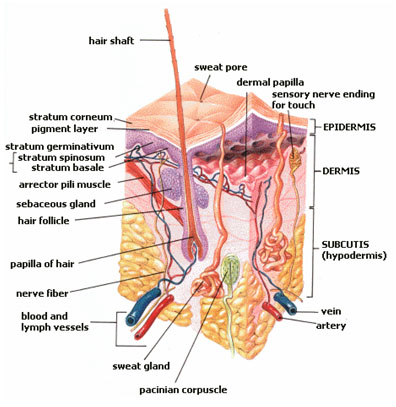5.3A: Sweat (Sudoriferous) Glands
- Page ID
- 7429
Sweat glands, also known as sudoriferous glands, are distributed over most of the body surface.
LEARNING OBJECTIVE
Classify eccrine and apocrine sweat glands
Key Takeaways
Key Points
- Sweat glands are located deep within the skin and primarily regulate temperature.
- The two main types of sweat glands are eccrine sweat glands and apocrine sweat glands.
- Eccrine sweat glands are smaller sweat glands. They are coiled tubular glands that discharge their secretions directly onto the surface of the skin.
- Apocrine sweat glands are coiled tubular glands that discharge in the canals of hair follicles. The sweat produced may be acted upon by bacteria, causing a noticeable odor.
Key Terms
- eccrine gland: The major sweat glands of the human body, found in virtually all skin, produce a clear, odorless substance, consisting primarily of water and NaCl.
- apocrine sweat gland: The type of sweat gland that is least responsible for thermoregulation and most responsible for body odor.
Sweat glands, also called sudoriferous glands, are simple tubular glands found almost everywhere on our body. Each sweat gland is made up of two portions:
- A secretory section
- An excretory duct
The secretory portion is found in the dermis, the middle layer of the skin. Sometimes it’s also found in the hypodermis, the deepest layer of our skin.
The secretory portion of a sweat gland is a twisted and coiled tube that has an opening at its very top. It is in the coiled secretory portion of the sweat gland where the sweat is actually produced. The excretory duct moves from the secretion portion, through the dermis, and into the topmost layer of the skin, the epidermis, where it opens up at the surface of our skin.
Eccrine Glands

Human Skin: Cross sectional image of skin showing a sweat gland and a sebaceous gland.
The most numerous types of sweat glands in our skin, found almost everywhere on the body, are called eccrine glands. These are the true sweat glands in the sense of helping to regulate body temperature. In other words, sweating causes the loss of body heat and thus cools us down on a hot day or when performing strenuous exercise. This is because as the water in sweat evaporates, it takes body heat with it.
Apocrine Glands
The other kind of sweat glands are known as apocrine glands. The apocrine glands are found in places like the armpits, scrotum, anus, and labia majora. They are typically larger than eccrine glands and their ducts tend to open into hair follicles instead of hairless areas of skin.
These glands, unlike the eccrine glands, serve virtually no role in the regulation of body temperature. These are also the glands largely responsible for body smells, as their excretions are converted by skin bacteria into various chemicals we associated with body odor.
Unlike eccrine glands, the exact function of apocrine glands is unknown and debated. We do know they are activated during times of stress, pain, and sexual foreplay but for what reasons is yet to be made clear.

